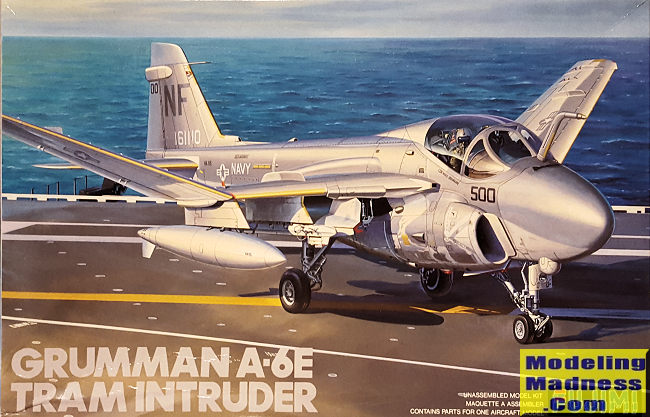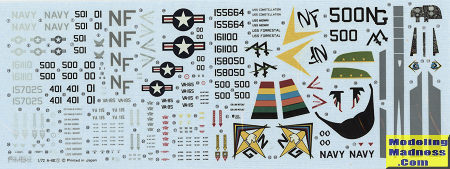
Fujimi 1/72 A-6E TRAM Intruder
| KIT #: | 27013 |
| PRICE: | 1200 yen SRP in 1987 |
| DECALS: | Via |
| REVIEWER: | Scott Van Aken |
| NOTES: | 1987 boxing |

| HISTORY |
The definitive attack version of the Intruder with vastly upgraded navigation and attack systems, The A-6E was introduced in 1970 and first deployed on 9 December 1971. The earlier separate search and track (fire control) radars of the A-6A/B/C were replaced by a single Norden AN/APQ-148 multi-mode radar, and onboard computers with a more sophisticated (and generally more reliable) IC based system, as opposed to the A-6A's DIANE discrete transistor-based technology. A new AN/ASN-92 inertial navigation system was added, along with the CAINS (Carrier Aircraft Inertial Navigation System), for greater navigation accuracy.
Beginning in 1979, all A-6Es were fitted with the AN/AAS-33 DRS (Detecting and Ranging Set), part of the "Target Recognition and Attack Multi-Sensor" (TRAM) system, a small, gyroscopically stabilized turret, mounted under the nose of the aircraft, containing a FLIR boresighted with a laser spot-tracker/designator and IBM AN/ASQ-155 computer. TRAM was matched with a new Norden AN/APQ-156 radar. The BN could use both TRAM imagery and radar data for extremely accurate attacks, or use the TRAM sensors alone to attack without using the Intruder's radar (which might warn the target). TRAM also allowed the Intruder to autonomously designate and drop laser-guided bombs. In addition, the Intruder used Airborne Moving Target Indicator (AMTI), which allowed the aircraft to track a moving target (such as a tank or truck) and drop ordnance on it even though the target was moving. Also, the computer system allowed the use of Offset Aim Point (OAP), giving the crew the ability to drop on a target unseen on radar by noting coordinates of a known target nearby and entering the offset range and bearing to the unseen target.
In the 1980s, the A-6E TRAM aircraft were converted to the A-6E WCSI (Weapons Control System Improvement) version to add additional weapons capability. This added the ability to carry and target some of the first generation precision guided weapons, like the AGM-84 Harpoon missile, and AGM-123 Skipper. The WCSI aircraft was eventually modified to have a limited capability to use the AGM-84E SLAM standoff land attack missile. Since the Harpoon and SLAM missiles had common communication interfaces, WCSI aircraft could carry and fire SLAM missiles, but needed a nearby A-6E SWIP to guide them to target.
In the early 1990s, some surviving A-6Es were upgraded under SWIP (Systems/Weapons Improvement Program) to enable them to use the latest precision-guided munitions, including AGM-65 Mavericks, AGM-84E SLAMs, AGM-62 Walleyes and the AGM-88 HARM anti-radiation missile as well as additional capability with the AGM-84 Harpoon. A co-processor was added to the AN/ASQ-155 computer system to implement the needed MIL-SPEC 1553 digital interfaces to the pylons, as well as an additional control panel. After a series of wing-fatigue problems, about 85% of the fleet was fitted with new graphite/epoxy/titanium/aluminum composite wings. The new wings proved to be a mixed blessing, as a composite wing is stiffer and transmits more force to the fuselage, accelerating fatigue in the fuselage. In 1990, the decision was made to terminate production of the A-6. Through the 1970s and 1980s, the A-6 had been in low-rate production of four or five new aircraft a year, enough to replace mostly accidental losses. The final production order was for 20 aircraft of the SWIP configuration with composite wings, delivered in 1993.The last Intruders were retired on 28 February 1997.
At the time of retirement, several retired A-6 airframes were awaiting rewinging at the Northrop Grumman facility at St. Augustine Airport, Florida; these were later sunk off the coast of St. Johns County, Florida to form a fish haven named "Intruder Reef". Surviving aircraft fitted with the new wings, as well as later production aircraft (i.e., BuNo 164XXX series) not earmarked for museum or non-flying static display were stored at the AMARG storage center at Davis-Monthan Air Force Base, Arizona
A-6E models totaled 445 aircraft, about 240 of which were converted from earlier A-6A/B/C models.
| THE KIT |
 This
isn't the first Intruder kit ever done and there have been ones out since in
this scale. But for most of us, this one is the best. Not surprisingly, it
incorporates most of the A-6A kit and adds a separate sprue with all the E mods,
such as they are.
This
isn't the first Intruder kit ever done and there have been ones out since in
this scale. But for most of us, this one is the best. Not surprisingly, it
incorporates most of the A-6A kit and adds a separate sprue with all the E mods,
such as they are.
Typical of most new tool 1/72 kits of the time, it relies on decals for instruments, has fair bang seats and provides crew members to help fill the cockpit. The kit does provide intake and exhaust trunking that leads to the appropriate compressor face. There are also three inserts for the lower fuselage that are fairly good size. Aircraft with twin fuselage mounted engines always seem to have the large inserts and are often one of the more difficult areas of construction in terms of getting a clean build with no seam issues. The speed brake inserts are also of the later version which is appropriate for most if not all the options. The perforated ones are on the sprue if you choose aftermarket decals that require them.
Though there is no folded
wing option, Fujimi gives you extendable slats. As noted in the history, the
TRAM system was not in early A-6Es so you have two radomes. I'd put in some
weight though none is shown. Landing gear is well done and the nose wheel doors
are molded as a single piece. Thanks to a 'tab' in this door, cutting it apart
will take a bit of skill. We are provided Three fuel tanks as well as a pair of
MERs and enough iron bombs to fit on them. On my kit, some of the fins on the
fuel tanks had broken away thanks to all the sprues jostling together in one
bag. 
Instructions are well done with the usual Gunze paint references. Three of the markings are from VA-115 and only these planes have the TRAM. Two of these are in the tactical paint scheme while the rest of the options are light gull grey over white with unpainted radomes. The other two options are CAG birds with one from VA-165 and the other from VA-85. The nicely printed decal sheet includes an anti-glare panel for the nose and wing walk areas.
| CONCLUSIONS |
This will make into a very nice model when you are done. I built the A-6A a few years back and recall it being a fairly nice experience. The kit is still fairly available in this and other boxings.
| REFERENCES |
Background courtesy of Wikipedia.
May 2020
Copyright ModelingMadness.com. All rights reserved.
If you would like your product reviewed fairly and fairly quickly, please contact the editor or see other details in the Note to Contributors.
Back to the Review Index Page Back to the Previews Index Page